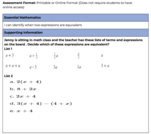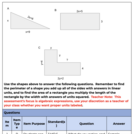
This lesson is using the distributive property to identify and write equivalent expressions.
- Subject:
- Mathematics
- Material Type:
- Lesson Plan
- Author:
- Pam Barber
- Date Added:
- 06/29/2021

This lesson is using the distributive property to identify and write equivalent expressions.

Jenny's Math Class: Standard 6.EE.4 Identify when two expressions are equivalent. For example, the expressions y + y + y and 3y are equivalent because they name the same number, regardless of which number y represents.
This formative assessment exemplar was created by a team of Utah educators to be used as a resource in the classroom. It was reviewed for appropriateness by a Bias and Sensitivity/Special Education team and by state mathematics leaders. While no assessment is perfect, it is intended to be used as a formative tool that enables teachers to obtain evidence of student learning, identify assets and gaps in that learning, and adjust instruction for the two dimensions that are important for mathematical learning experiences (i.e., Standards for Mathematical Practice, Major Work of the Grade).

Shapes: Standard 6.EE.3 Apply the properties of operations to generate equivalent expressions. For example, apply the distributive property to the expression 3(2 + x) to produce the equivalent expression 6 + 3x; apply the distributive property to the expression 24x + 18y to produce the equivalent expression 6(4x + 3y); apply properties of operations to y + y + y to produce the equivalent expression 3y.
This formative assessment exemplar was created by a team of Utah educators to be used as a resource in the classroom. It was reviewed for appropriateness by a Bias and Sensitivity/Special Education team and by state mathematics leaders. While no assessment is perfect, it is intended to be used as a formative tool that enables teachers to obtain evidence of student learning, identify assets and gaps in that learning, and adjust instruction for the two dimensions that are important for mathematical learning experiences (i.e., Standards for Mathematical Practice, Major Work of the Grade).

Build coin expressions, then exchange them for variable expressions. Simplify and evaluate expressions until you are ready to test your understanding of equivalent expressions in the game!